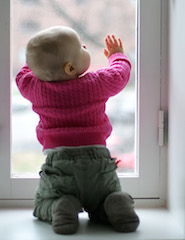Observe Window Safety Year Round: Eight Tips from the National Safety Council for Window Safety Week, April 5-11
 As spring arrives, the National Safety Council’s Window Safety Task Force encourages everyone to recognize the importance of practicing window safety year-round. Window Safety Week is observed April 5-11. However, open windows any time of year can be dangerous for young children who are not properly supervised. While the number of falls from windows is generally very small compared with other recorded child injuries, a window incident can result in serious injury or possibly even death.
As spring arrives, the National Safety Council’s Window Safety Task Force encourages everyone to recognize the importance of practicing window safety year-round. Window Safety Week is observed April 5-11. However, open windows any time of year can be dangerous for young children who are not properly supervised. While the number of falls from windows is generally very small compared with other recorded child injuries, a window incident can result in serious injury or possibly even death.
Each year, he Window Safety Task Force of the National Safety Council takes the first full week in April to educate on the importance of practicing window safety year-round. National Window Safety Week is designed to increase awareness on helping to prevent accidental window falls and the proper use of windows for emergency escape purposes.
Falls from a window can result in serious injury or death and pose an especially dangerous threat for children. Every year, about eight children under age five die each year from falling out a window, and more than 3,300 are injured seriously enough to go to the hospital.
“It only takes seconds for a preventable window fall to occur,” said Amy Artuso, program manager for the National Safety Council. “To avoid these needless tragedies, it is very important for parents and caregivers to take steps to prevent home falls.”
To protect children, the Window Safety Task Force offers the following eight safety tips:
• When young children are around, keep windows closed and locked.
• When opening a window for ventilation, use those located out of a child’s reach. For example, the upper sash of a double hung window.
• Avoid placing furniture near windows to prevent young children from climbing.
• Don’t allow children to jump on beds or other furniture to help reduce potential falls.
• Don’t rely on insect screens to prevent a window fall. Insect screens are designed to keep bugs out, not to keep children in the home.
• Supervise children to keep child’s play away from windows, balconies or patio doors. Keep play in the center of a room, if possible.
• Install code-compliant devices designed to limit how far a window will open or window guards (with quick-release mechanisms in case of fire) to help prevent a fall.
• Teach your child how to safely use a window to escape during an emergency, such as a fire.
Visit http:/www.aamanet.org/windowsafety to learn more.
* According to Safe Kids Worldwide’s 2015 Report to the Nation: Protecting Children in Your Home
About the Window Safety Task Force
The Window Safety Task Force was formed in 1997 to promote greater awareness of window safety. The task force is comprised of members representing the American Architectural Manufacturers Association (AAMA), the Window & Door Manufacturers Association (WDMA) and the Screen Manufacturers Association (SMA) in cooperation with the National Association of Home Builders (NAHB), and other organizations, as well as manufacturers of windows, doors and screens. The National Safety Council saves lives by preventing injuries and deaths at work, in homes, communities and on the roads, through leadership, research, education and advocacy.
About the National Safety Council
Founded in 1913 and chartered by Congress, the National Safety Council, nsc.org, is a nonprofit organization whose mission is to save lives by preventing injuries and deaths at work, in homes and communities, and on the roads through leadership, research, education and advocacy. NSC advances this mission by partnering with businesses, government agencies, elected officials and the public in areas that can make the most impact – distracted driving, teen driving, workplace safety, prescription drug overdoses and Safe Communities.
###
Filed under: AAMA, ASSOCIATION NEWS